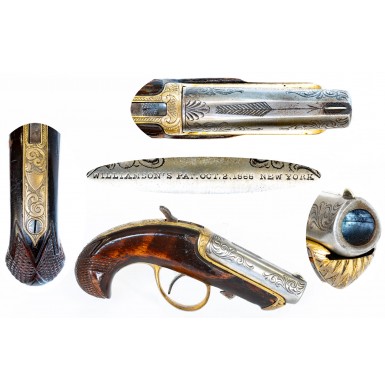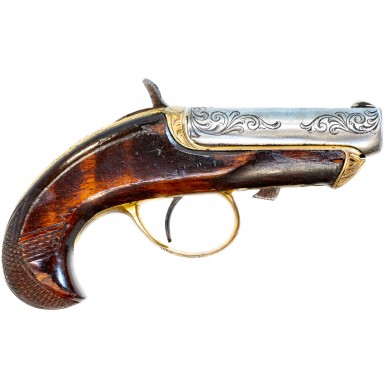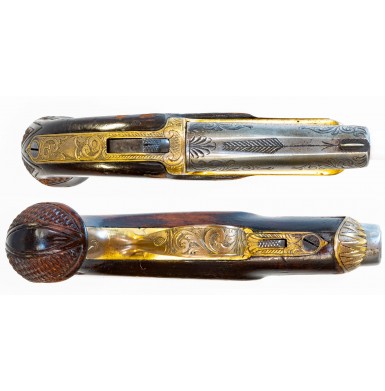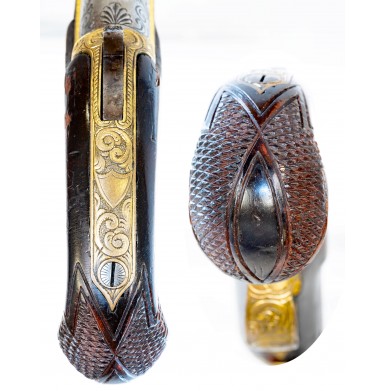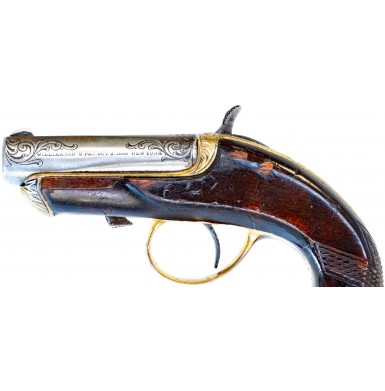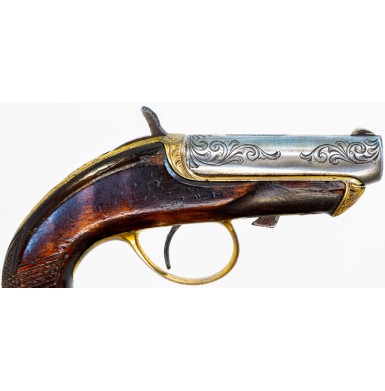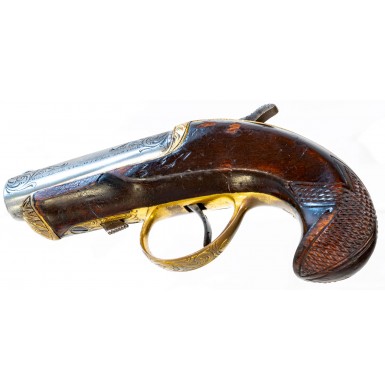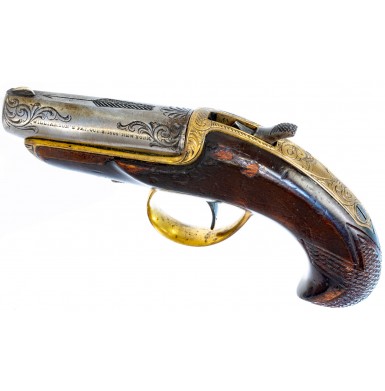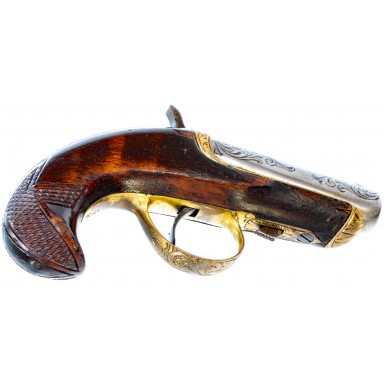Scarce Gilt Frame and Engraved Barrel Williamson Patent Derringer
- Product Code: FHG-3C1066
- Availability: In Stock
-
$1,995.00
The mid-19th century in America was a time of great strides in the development of firearms. The percussion era, which was only a couple of decades old, was rapidly ending as the new self-contained metallic cartridges were becoming more common and more reliable. In the field of revolver development, designers were all trying to circumvent the Rollin White patent that protected the bored-through cylinder concept. This resulted in numerous novel attempts to evade that patent as these interesting designs were introduced in an attempt to capture part of the metallic cartridge revolver market. Even more non-revolver metallic cartridge handguns were introduced, as that market was not nearly as restricted by patent holdings as was the revolver market. By simply coming up with a unique latching system for locking the barrel or barrels closed, or a unique interlock system to prevent accidental discharges when the action was not closed, a designer could acquire a patent and offer a new product on the market.
One of the designers who was active in metallic handgun design this period was David Williamson of New York City. According to the 1850 Census, David was born about 1838 and was the second oldest of the six children of James and Mary Williamson. The Williamsons were Scottish immigrants and had arrived in New York on the steamship Elizabeth on 2 June 1848. David was nine years old at the time. David Williamson was apparently mechanically minded, and most census records list his occupation as a “mechanical engineer & machinist”. Sometime around 1862 David went to work for the Moore’s Patent Firearms Company. Daniel Moore’s company is probably best known for the manufacture of their Front-Loading Teat Fire Pocket Revolver and their Single Action “Seven Shot” Belt Revolver. The latter was a Daniel Moore patented design that was intended to circumvent the Rollin White bored-through cylinder patent that was held by Smith & Wesson. Litigation by Smith & Wesson brought the production of these guns to an end within a couple of years of their introduction. The Front-Loading Teat Fire Revolver was another Rollin White patent evasion design that Williamson was likely working on as the Smith & Wesson litigation was ongoing for the other revolver design. On 31 June 1863 Williamson became the superintendent of the Moore Firearms Company due to the resignation of Daniel Moore. On 5 January 1864 Williamson received his patent for the front-loading revolver design. In 1865 the Moore Patent Firearms Company was acquired by the National Arms Company of Brooklyn, NY. The production of the Front-Loading Revolver continued as did a .41RF single shot, all metal derringer that had been designed by Moore.
On 2 October 1866 Williamson received US Patent #58524 for his single-shot metallic cartridge derringer. His patent covered two primary claims. The first was the under-barrel latching system that kept the barrel in battery and was which released it to load and unload the pistol. The second concept was an interlock system that prevented the latch from moving and allowing the barrel to open when the pistol was at half cock. Another feature in the patent application was a removable chamber insert that allowed the pistol to be used as a percussion handgun if metallic cartridge ammunition was not available.
The Williamson Patent Derringer was a departure from the all-metal Moore designed pistol that the company had introduced in 1860 or 1861. That pistol had been a spur-trigger design that used a pivoting barrel to achieve loading and unloading, similar to the pivoting barrel and cylinder of the Moore Belt Revolver. Williamson’s design was a simple sliding barrel system that was similar to the Sharps’ Pepperboxes of the 1850s. Like the Sharps design, a pushing a release under the barrel allowed it to be slid forward for loading and unloading. As noted, the design also included a safety interlock system that prevented the barrel release from being activated if the hammer was in any position other than the “down” or “fired” position. The silhouette of the pistol was very traditional, and clearly influenced by the progenitor of the American derringer, Henry Deringer. The pistol had a wood stock with a bird’s head grip profile into which a metal frame was installed with rails that allowed the barrel to slide forward. The pistol had a single action firing mechanism with a conventional trigger and triggerguard. The pistols were produced in .41RF, like the earlier Moore design and utilized a 2 ½” barrel with a round bottom, a tapered triangular profile and a full-length, elongated nocksform. Like most handguns of the period, the Williamson derringer was available in a variety of finishes and various levels of embellishment. The standard production variant had a blued barrel, a silver-plated brass frame and a checkered walnut stock. The frames were typically scroll engraved while the barrels were marked with an arrow motif and the Williamson patent information. A small number of the guns were stocked in tiger stiped maple and a couple of extant examples are known with ivory stocks. A small number of guns were produced with gold gilt frames and other barrel finishes such as nickel and much more rarely silver are known. Another rare extra cost feature was scroll engraving on the barrel. The pistols were serial numbered, or possibly assembly numbered, on the interior of the frame and under the barrel. Serial numbers of extant examples suggest that production of these derringers approached 20,000 pieces from the gun’s introduction in 1866 through the end of operations in 1870 when Colt purchased National Arms and discontinued this model. However, the scarcity of surviving examples suggests that at most actual production was half that. This may indicate that the “serial numbers” were really assembly mating numbers and may have had nothing to do with the numbers produced. It was also not uncommon for gunmakers of the period to inflate their apparent production figures by starting new serial number series on a monthly basis, even if that number had not been reached. For example, if production started with #1,000 in January of a year and 300 guns were produced that month, February might start at #2,000, even though only 300 had been made the month before. This allowed the makers to create the impression that their guns were being produced in larger numbers and were more popular than they really were.
Offered here is a scarce example of a gilt frame, engraved barrel Williamson Patent Derringer by National Arms. The pistol was produced with a silvered, scroll-engraved barrel, a gold-plated engraved brass frame and a checkered walnut stock. The top of the barrel is engraved with the classic “Arrow Motif” that is typically associated with Moore’s No 1 all-metal derringers, as produced by Moore, National Arms, and later Colt. The left side of the barrel is marked with the patent information in a single line and reads:
WILLIAMSON’S PAT. OCT. 2. 1866 NEW YORK
The barrel is engraved with simple flowing Arabesque scrolls on both sides at the breech and muzzle and with a shell motif on the top of the breech. The gilt brass frame is engraved ensuite with flowing scrolls on the backstrap and geometric boarder patterns around the breech face and surrounding the hammer. The engraving is classic “New York Style” work and clearly influence by L.D. Nimschke. The gun is “serial number” 4810, and that is visible under the barrel when the action is open.
The pistol remains in about VERY GOOD+ condition overall with clear markings and crisp engraving throughout. The barrel retains essentially no finish on its exterior, but some minor traces of silver are found on the bottom of the barrel where it has been protected by the frame. The exterior of the barrel has a medium pewter patina with scattered patches of dark surface oxidation and discoloration. The metal is mostly smooth with some scattered freckles of light pinpricking and some minor areas of lightly scattered surface roughness. The brass frame retains about 30%+ of its gilded finish, with most of the loss due to wear along the high edges and points of contact. The exposed brass has a nice, rich butterscotch patina that is very attractive. The wood stock is in about VERY GOOD condition as well. It shows moderate wear and numerous scattered bumps, dings, and minor surface mars from carry, use and handling. Wood stocks on derringer type pistols often show significant wear due to long term pocket carry. As is often the case with Williamson pistols, the “forend” of the gun (the wood from the barrel release to the stock tip) shows the most wear and damage, with a tiny chip missing behind the forend cap on the obverse, along with a short, repaired crack in that area. The reverse shows a small sliver of wood along the top edge of the stock at the forend tip that has been replaced. The repairs are well executed and not immediately obvious without fairly serious scrutiny. Despite the wear that wood shows, the checkering remains fairly crisp and sharp in the grip area and the minor wood damage does not in any way detract from the overall appearance of the pistol. The pistol remains in VERY GOOD mechanical condition and functions correctly in every way. The hammer locks into each notch as it should and responds correctly to the trigger. The barrel release works as it should, as does the interlock safety mechanism. The action is a little tight, but the barrel will slide forward as it should with a little effort when the hammer is down, and the release is pressed. The bore of the pistol rates about VERY GOOD to NEAR FINE. It is mostly bright with strong rifling but shows some scattered patches of oxidized discoloration as well as
Overall, this is a very nice example of one of the rare gilt frame and engraved barrel examples of a Williamson Patent Derringer. These guns were only produced for a fairly short period of time and were an interesting transition from the traditional Henry Deringer profile pocket pistol to the more modern metallic cartridge handguns. This is a lovely example with crisp engraving and some nice gilt finish on the frame that will display very nicely in your collection. It will be a fine addition to any collection of pocket pistols, derringers, or early metallic cartridge handguns that I am sure you will enjoy owning.
Tags: Scarce, Gilt, Frame, and, Engraved, Barrel, Williamson, Patent, Derringer

